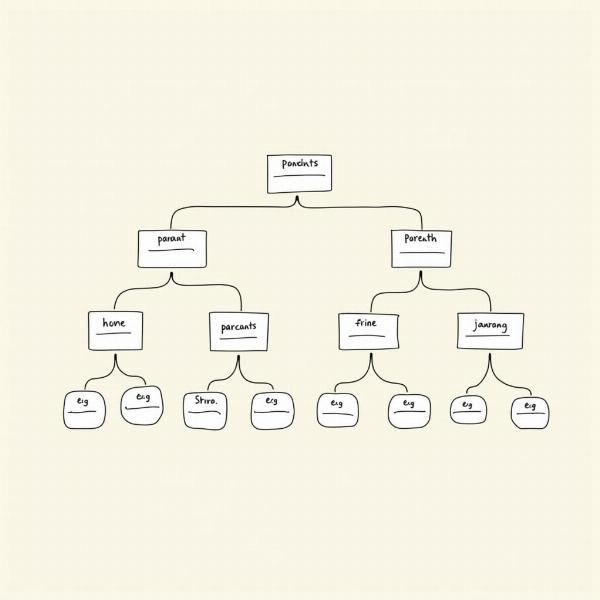Lineal meaning in Hindi revolves around concepts of lineage, ancestry, and direct descent. Understanding the nuances of this term requires exploring various Hindi words and their cultural significance within the Indian context. This article will delve into the different ways “lineal” can be translated and used in Hindi, examining its implications in genealogy, inheritance, and social structures.
Exploring the Hindi Translations of “Lineal”
Several Hindi words capture different facets of the English term “lineal.” These include:
- वंशज (Vanshāj): This is perhaps the closest equivalent, meaning “descendant” or “offspring.” It emphasizes the direct line of descent from an ancestor.
- वंश परंपरा (Vansh Paramparā): This phrase translates to “family tradition” or “lineage,” highlighting the continuity of customs and practices passed down through generations.
- पीढ़ी दर पीढ़ी (Peeṛhī Dar Peeṛhī): Meaning “generation after generation,” this emphasizes the unbroken chain of lineal descent.
- रक्त संबंध (Rakt Sambandh): This term translates to “blood relation” and encompasses the broader concept of kinship ties, including lineal relatives.
- सीधी रेखा (Sīdhī Rekhā): Literally meaning “straight line,” this can be used metaphorically to represent direct lineage.
Lineal Descent and Inheritance in Indian Culture
The concept of lineal descent plays a crucial role in Indian inheritance laws and social customs. Traditionally, property and titles were passed down through male lineage (पितृवंशीय – Pitṛivaṃśīya). However, modern laws have evolved to grant equal rights to female heirs. Understanding the intricacies of lineal relationships is essential for navigating inheritance matters. Moreover, lineal descent often determines social standing and responsibilities within families and communities.
Lineal Relationships and Family Structures
In India, family structures are often defined by lineal relationships. Respect for elders and the continuation of family traditions are highly valued. The concept of “kul” (कुल), referring to an extended family group tracing its lineage to a common ancestor, reinforces the importance of lineal connections. These connections shape social interactions, marriage alliances, and community dynamics.
How to Determine Lineal Descendants?
Determining lineal descendants involves tracing the direct line of ancestry from one generation to the next. Genealogical records, family trees, and historical documents can be valuable resources. In some cases, DNA testing can also help establish lineal relationships.
What are the different types of lineal relationships?
Lineal relationships can be categorized as ascending (parents, grandparents, etc.) or descending (children, grandchildren, etc.). Understanding these distinctions is crucial for legal and genealogical purposes.
 Chart illustrating lineal ascendants and descendants
Chart illustrating lineal ascendants and descendants
Conclusion
Understanding “lineal meaning in Hindi” goes beyond simple translation. It encompasses a deeper understanding of Indian culture, family structures, and inheritance practices. From “वंशज” (Vanshāj) to “रक्त संबंध” (Rakt Sambandh), the various Hindi terms related to lineage highlight the multifaceted nature of this concept. By exploring these nuances, we gain a richer appreciation for the importance of lineal connections in the Indian context.
FAQ
- What is the most common Hindi word for “lineal”? The most common Hindi word for “lineal” is “वंशज” (Vanshāj), meaning descendant.
- How is lineal descent related to inheritance in India? Lineal descent plays a crucial role in determining inheritance rights in India, though modern laws have evolved to provide greater equality.
- What is the significance of “kul” in the context of lineal relationships? “Kul” refers to an extended family group sharing a common ancestor, emphasizing the importance of lineal connections in Indian society.
- How can I trace my lineal ancestors? Genealogical records, family trees, and historical documents can be helpful resources for tracing lineal ancestors.
- What are the different types of lineal relationships? Lineal relationships can be ascending (e.g., parents, grandparents) or descending (e.g., children, grandchildren).
Meaning-Hindi.in is your trusted partner for accurate and culturally sensitive Hindi translation services. We specialize in various translation domains, from legal and business documents to technical manuals and website localization. Our expertise in Indian culture and language ensures your message is conveyed effectively and respectfully. Contact us today for all your Hindi translation needs at [email protected] or +91 11-4502-7584. Meaning-Hindi.in is dedicated to bridging the language gap and fostering clear communication.
Liên kết Nội bộ:
cousin sister in hindi meaning provides a detailed explanation of family relationships.
mothers maiden name hindi discusses the cultural significance of maiden names.
metronymics meaning in hindi explores the use of metronymics in Indian culture.
son of in hindi meaning provides various ways to express “son of” in Hindi.